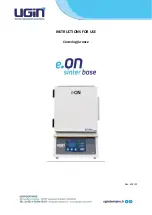
41
MAINTENANCE
Annual Inspection
The furnace should be inspected by a qualified installer, or
service agency at least once per year. This check should be
performed at the beginning of the heating season. This will
ensure that all furnace components are in proper working order
and that the heating system functions appropriately. Pay
particular attention to the following items. Repair or service as
necessary.
■
Flue pipe system. Check for blockage and/or leakage. Check
the outside termination and the connections at and internal to
the furnace.
■
Heat exchanger. Check for corrosion and/or buildup within
the heat exchanger passageways.
■
Burners. Check for proper ignition, burner flame and flame
sense.
■
Drainage system. Check for blockage and/or leakage. Check
hose connections at and internal to furnace.
■
Wiring. Check electrical connections for tightness and/or
corrosion. Check wires for damage.
■
Filters
Filters
Filter Maintenance
Improper filter maintenance is the most common cause of
inadequate heating or cooling performance. Filters should be
cleaned (permanent) or replaced (disposable) every 2 months or
as required. When replacing a filter, it must be replaced with a
filter of the same type and size.
Filter Removal
Depending on the installation, differing filter arrangements can be
applied. Filters can be installed in either the central return register
or a side panel external filter rack (upflow only). A media air filter
or electronic air cleaner can be used as an alternate filter. Follow
the filter sizes given in the Recommended Minimum Filter Size
chart to ensure proper unit performance.
To remove filters from an external filter rack in an upright upflow
installation, follow the directions provided with external filter rack
kit.
Horizontal Unit Filter Removal
Filters in horizontal installations are located in the central return
register or the ductwork near the furnace.
To remove:
1. Turn off electrical power to the furnace.
2. Remove the filter(s) from the central return register or
ductwork.
3. Replace the filter(s) by reversing the procedure for removal.
4. Turn on electrical power to the furnace.
Media Air Filter or Electronic Air Cleaner Removal
Follow the manufacturer’s directions for service.
Burners
Visually inspect the burner flames periodically during the heating
season. Turn on the furnace at the thermostat and allow several
minutes for flames to stabilize, since any dislodged dust will alter
the flames normal appearance. Flames should be stable, quiet,
soft and blue (dust may cause orange tips but they must not be
yellow). They should extend directly outward from the burners
without curling, floating or lifting off. Flames must not impinge on
the sides of the heat exchanger firing tubes.
Induced Draft and Circulator Blowers
The bearings in the induced draft blower and circulator blower
motors are permanently lubricated by the manufacturer. No
further lubrication is required. Check motor windings for
accumulation of dust which may cause overheating. Clean as
necessary.
Condensate Trap and Drain System
(Qualified Servicer Only)
Annually inspect the drain tubes, drain trap and field-supplied
drain line for proper condensate drainage. Check drain system
for hose connection tightness, blockage and leaks. Clean or
repair as necessary.
Flame Sensor (Qualified Servicer Only)
Under some conditions, the fuel or air supply can create a nearly
invisible coating on the flame sensor. This coating acts as an
insulator causing a drop in the flame sense signal. If the flame
sense signal drops too low, the furnace will not sense flame and
will lock out. The flame sensor should be carefully cleaned by a
qualified servicer using emery cloth or steel wool. Following
cleaning, the flame sense signal should be as indicated in the
Specifications Sheet.
HIGH VOLTAGE!
WARNING
To avoid personal injury or death due to
electrical shock, disconnect electrical power
before performing any maintenance. If you
must handle the igniter, handle with care.
Touching the igniter element with bare fingers,
rough handling or vibration could damage the igniter
resulting in premature failure. Only a qualified servicer
should ever handle the igniter.
To ensure proper unit performance, adhere to the filter
sizes given in the Recommended Minimum Filter Size
chart or Specification Sheet applicable to your model.
CAUTION











































